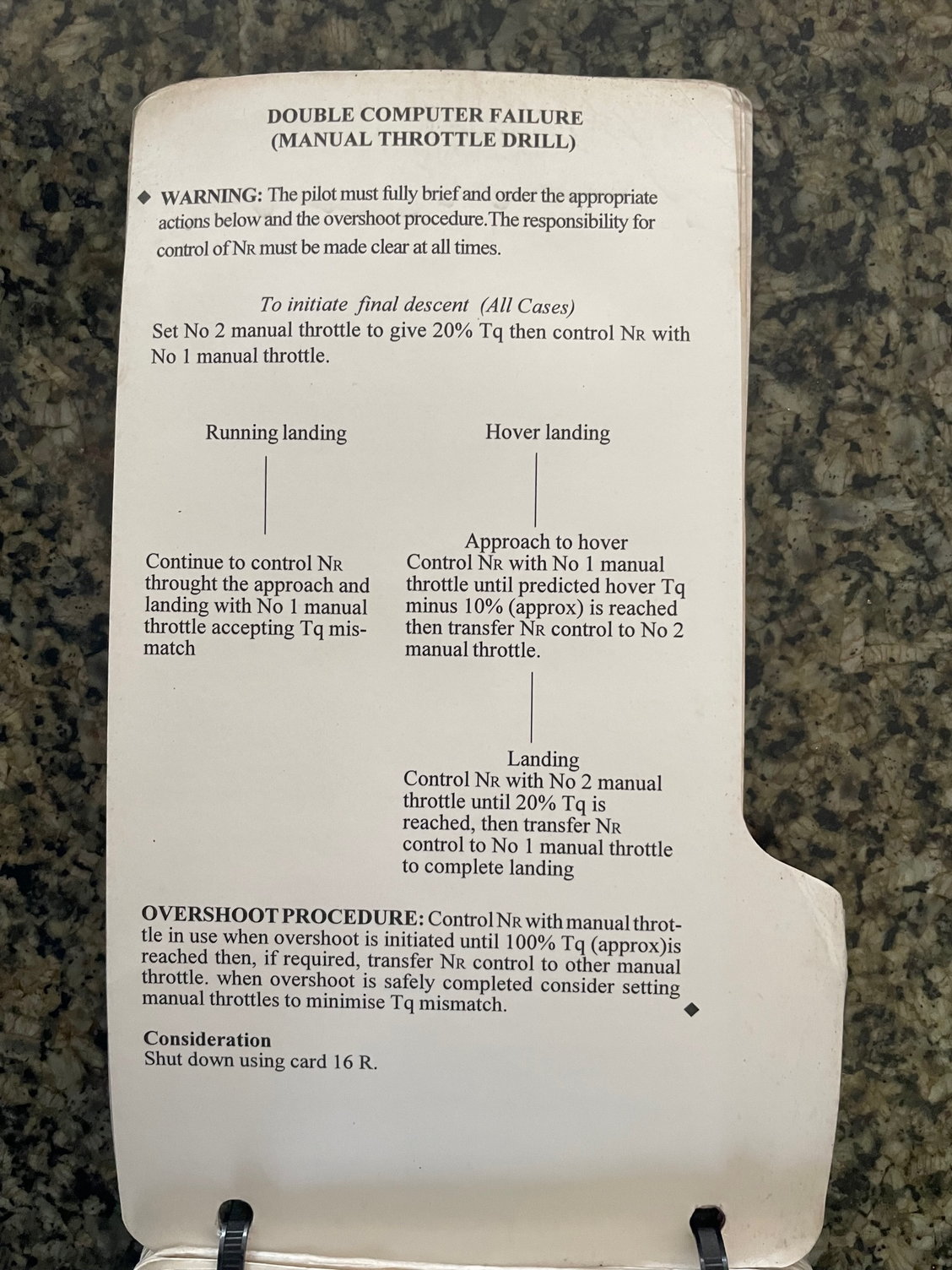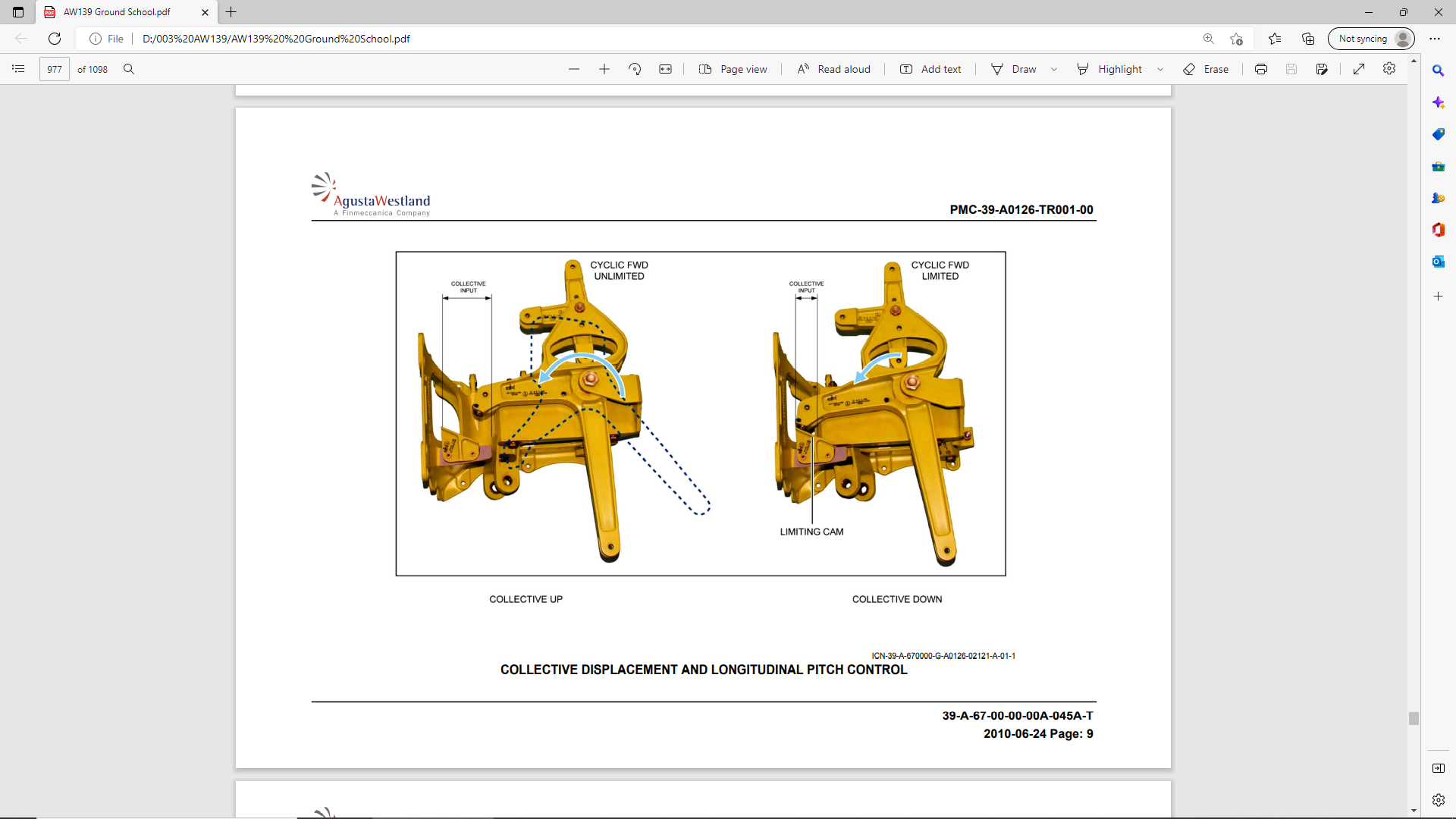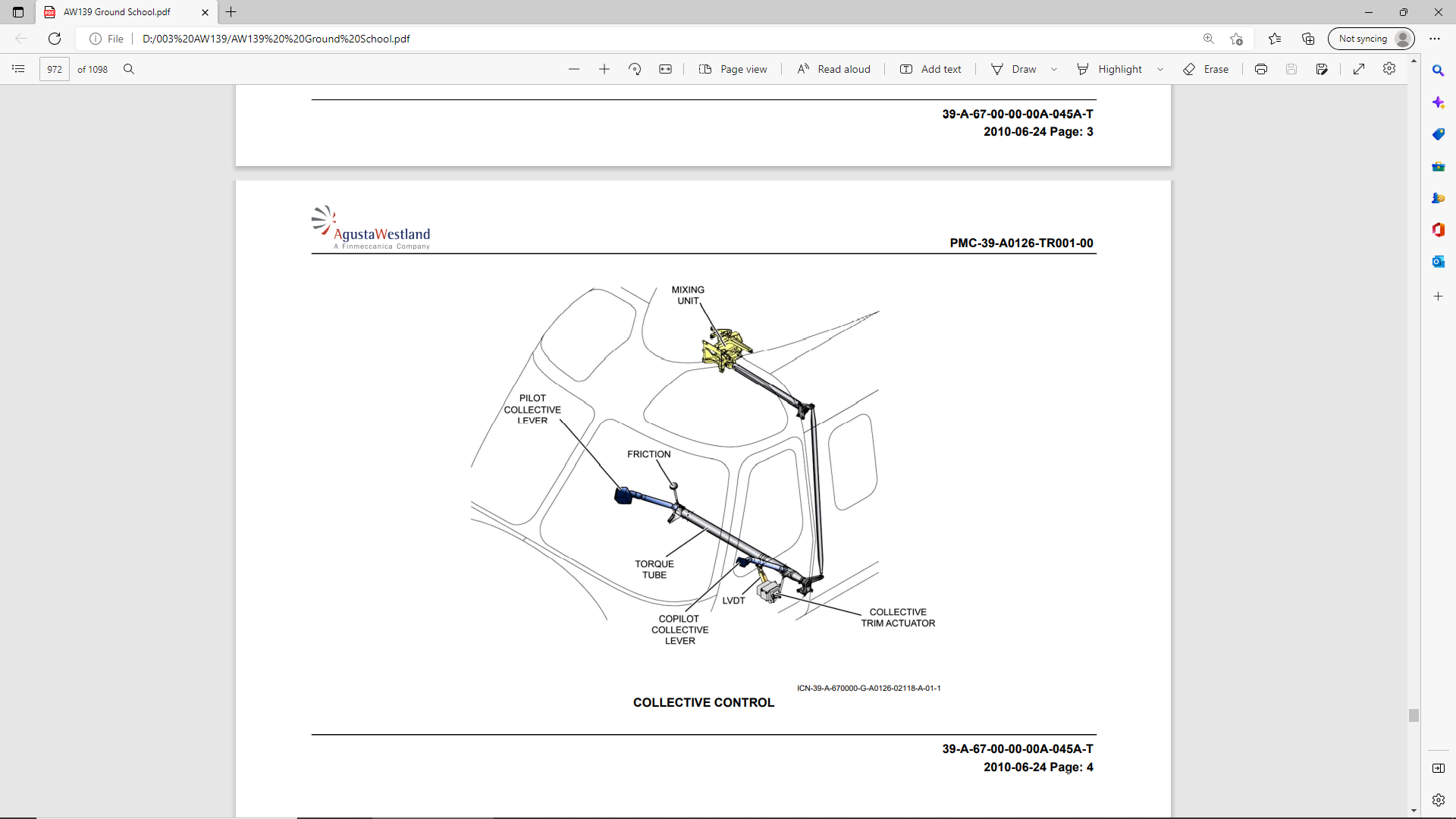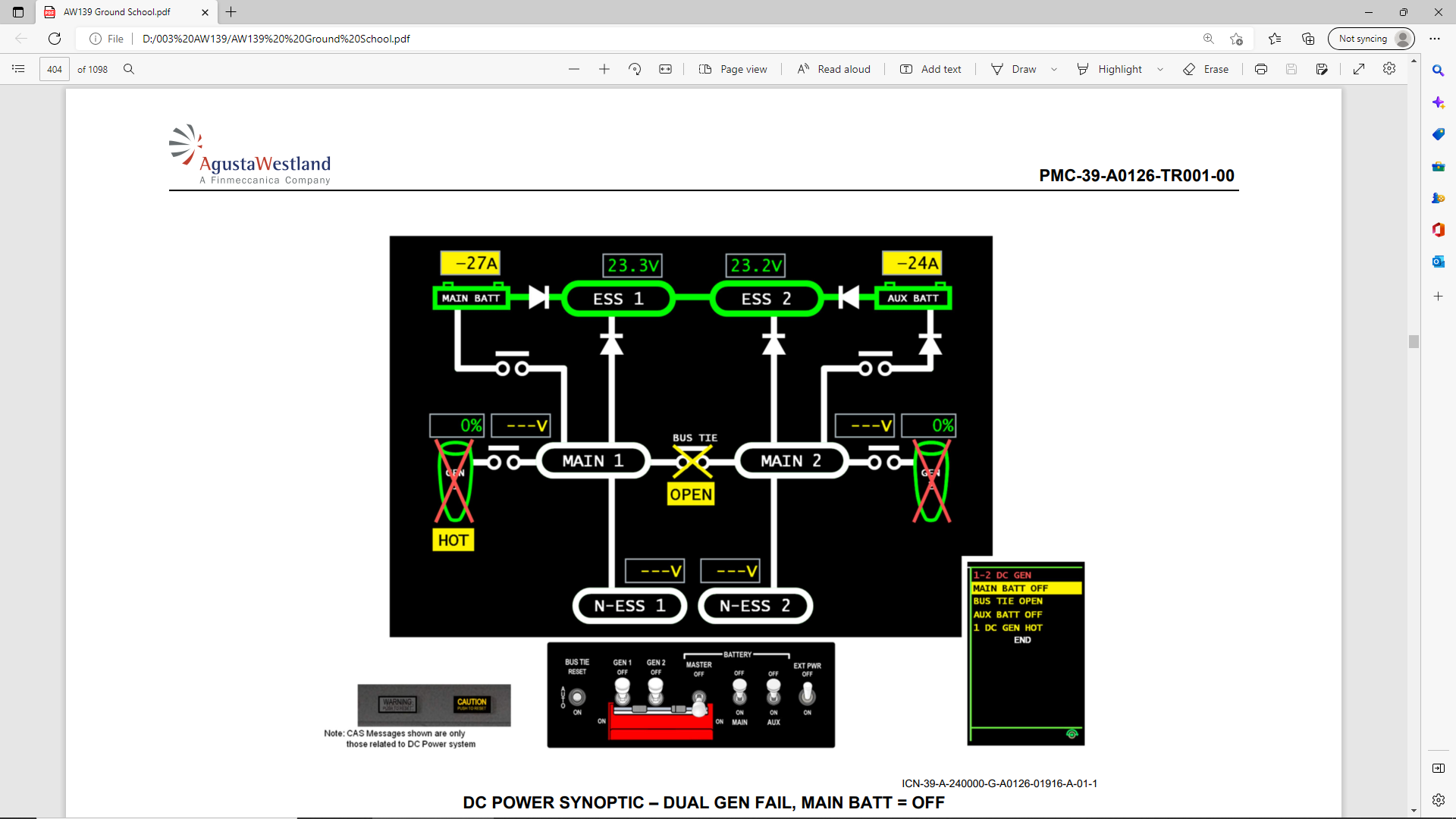AW139 incident - Houma
But unless you have lost the EECs, the need for manual control and the beep trims isn't required.
For the interest of any other 139 drivers who find themselves with double EEC fail - here is the page from the Sea King FRCs

It requires sympathetic handling from the PF and good CRM to establish who has control of the Nr.
For the interest of any other 139 drivers who find themselves with double EEC fail - here is the page from the Sea King FRCs

It requires sympathetic handling from the PF and good CRM to establish who has control of the Nr.
Thread Starter
212 man, that's because jgt is incorrect. Crab is right, they override the manual beep trims, and if all the electrics were off due to the fire, these beep trims wouldn't have worked at all as they need electrics to motor, so all you have would be the good old wire from the ecl's to the engine.
B.
B.
In my limited experience of the 139, despite the questions and inferences raised above, the 139 ECL do not control engines when in automatic unlike some older acft,,,other than provide a fuel shutoff capability as JGtn points out. You must select manual mode first, and you must have electrical power to do so. As mentioned,
If the EECs fail, the engines revert to manual mode without needing to have the switch selection made on the collective
MANUAL MODE - ECC FAIL In case of a critical failure of the EEC, the 1(2) EEC FAIL warning message is displayed in the CAS (associated with aural warning message WARNING – WARNING). The engine control system automatically enters into MANUAL mode: the FMM torque motor is disables and fuel flow can only be adjusted by moving the ECL. ECL position can be remotely controlled by acting on the ENG TRIM switches on the collective lever. ECL can also be manually moved by grasping it.
Seems we have several modes to consider here.
Normal, Emergency, and whatever the rrew had to operate with because the electrical fire and its effects.
I am understanding the ECL's in "Normal" do not effect engine power settings as they are moved from FLY (or whatever the postion is called) but acts like a Fuel Shutoff and engine control is by means of Beep Trim Switches.
In EMERGENCY they do control Engine Power Settings and can be modulated by movement all the way back to the Fuel Cutoff position.
Now the rub comes when Switches like both GENS, BAT MAIN and BAT Master get moved to the OFF position......I remain unclear as to what happens then re Engine Control.
Finally.....we do not know what effect the Electrical fire had in any or all of the above.
Am I getting this right......you 139 guys set me straight if I still do not have it right.
Normal, Emergency, and whatever the rrew had to operate with because the electrical fire and its effects.
I am understanding the ECL's in "Normal" do not effect engine power settings as they are moved from FLY (or whatever the postion is called) but acts like a Fuel Shutoff and engine control is by means of Beep Trim Switches.
In EMERGENCY they do control Engine Power Settings and can be modulated by movement all the way back to the Fuel Cutoff position.
Now the rub comes when Switches like both GENS, BAT MAIN and BAT Master get moved to the OFF position......I remain unclear as to what happens then re Engine Control.
Finally.....we do not know what effect the Electrical fire had in any or all of the above.
Am I getting this right......you 139 guys set me straight if I still do not have it right.
Yes, in normal (auto) mode the ECLs can shut down the engines.
Yes, in Manual ,mode they control the engines like most other aircraft.
If the EECs fail which I believe would include a loss of electrical power, then the engines revert to manual control automatically.
The fire seems to have had more impact on the ability to change collective pitch than control over the engines but I don't know what connections are involved in that wiring bundle that was chafed, nor what effect those wires shorting out would have on the rest of the electrical system.
The best thing is that the crew are on the ground safely to give feedback on the emergency(s) that they had to deal with rather than us waiting for the FDR to produce answers long after the event.
I hope their pax bought them a lot of beer.
Yes, in Manual ,mode they control the engines like most other aircraft.
If the EECs fail which I believe would include a loss of electrical power, then the engines revert to manual control automatically.
The fire seems to have had more impact on the ability to change collective pitch than control over the engines but I don't know what connections are involved in that wiring bundle that was chafed, nor what effect those wires shorting out would have on the rest of the electrical system.
The best thing is that the crew are on the ground safely to give feedback on the emergency(s) that they had to deal with rather than us waiting for the FDR to produce answers long after the event.
I hope their pax bought them a lot of beer.
Yes, in normal (auto) mode the ECLs can shut down the engines.
If the EECs fail which I believe would include a loss of electrical power, then the engines revert to manual control automatically.
They will remain in AUTO until told otherwise by MODE selection discretes, OFF, IDLE, FLY or MAN/AUTO or at the decision of the EEC logic if it loses enough info to do the job i.e too many critical faults. Single channel system.
In the AW109 which at a guess is not too much different if you move the ECL by hand it overrides the clutch to the "beep" motor and activates a microswitch which will place the EEC in MANUAL. Of course there is the caveat to assume that all the wiring is intact and if not then all bets are off.
Be nice to know if the 139 is the same and I guess we will eventually find out for sure. Pretty sure the ability to "beep" the ECL from the normal position DOWN and then back UP to normal when in AUTO is a pre-flight test requirement?
Incidentally if you have faults on the PWC system they are normally movement from airframe vibration causing loose connectors and the result of fretting inside the connector pins and sockets. There is quite an involved procedure to tightening the connectors and applying connector enhancer (Stabilant 22). What it is exactly or how it works is voodoo but it definitely works. If you don't pay close attention to the procedure you will suffer for it. In some frames you can see the connector but...........................
AUTO to MAN and back to AUTO will perform the equivalent of Control-Alt-Del and "reboots" the EEC. Handy when you have a Non Critical Fault and a degrade caused by the previously mentioned connector issues and if the fault is intermittent it will normally clear the degrade. Until the next occurrence of course.
The fire seems to have had more impact on the ability to change collective pitch than control over the engines but I don't know what connections are involved in that wiring bundle that was chafed, nor what effect those wires shorting out would have on the rest of the electrical system.
Having been in the game as both "cyclic attendant" and "black-hander" for a few years you get a feel for what works and where to look for what doesn't. I have not laid spanners on a 139 but have had a good look around one and there are a few "eyebrow raisers". Sure nothing is perfect and there is some really good engineering and they sell well and definitely go like crap off a chrome shovel but they have also shucked a few fairly important pieces over the years and there are some areas that are a bit neanderthal.........
Full kudos to the guys at the sharp end and way too close to nearly "buying the farm".
Thread Starter
Full kudos to the guys at the sharp end and way too close to nearly "buying the farm".
Actually, these kind of incidents are in QF32 territory but with less time to fix and more serious symptoms to handle.
Last edited by 212man; 22nd Oct 2022 at 21:09.
So just for clarification is there a fully mechanical connection between the ECL “Throttle Levers” and the fuel control?
If so would it have been possible to control power and RPM by using them given that the collective was essentially stuck at a fixed pitch due to the carbon fibre control rod being reduced to a liquorice stick.
Forgive my ignorance but the references to Emergency Procedures in aircraft types not involved are interesting asides but have me a bit confused.
I assume that in addition to the AD there will soon be a new control rod available manufactured of a more durable and heat resistant material.
( I am sure some will advocate for a 1 inch solid titanium or stainless steel rod.)
The crew must have been very amazed at what was happening. Glad they got down safely. Well done.
If so would it have been possible to control power and RPM by using them given that the collective was essentially stuck at a fixed pitch due to the carbon fibre control rod being reduced to a liquorice stick.
Forgive my ignorance but the references to Emergency Procedures in aircraft types not involved are interesting asides but have me a bit confused.
I assume that in addition to the AD there will soon be a new control rod available manufactured of a more durable and heat resistant material.
( I am sure some will advocate for a 1 inch solid titanium or stainless steel rod.)
The crew must have been very amazed at what was happening. Glad they got down safely. Well done.
So the similarities to 139 will exist amongst others like AW109, EC135P models, MD902 and Bell 427 and 429.
The mechanical connection does vary between overhead levers and twist grips and is supplied by the framers. Naturally there are some slight differences in the way things are implemented.
If so would it have been possible to control power and RPM by using them given that the collective was essentially stuck at a fixed pitch due to the carbon fibre control rod being reduced to a liquorice stick.
Not aware of what is/was trained for in this instance.
So chafing, fire, collective tube in ceiling compromised. Not sure why the low rotor rpm at that point, both engines at 145% as the EEC/PMA tries to keep the NR at 100%. Both engines running, but the MR pitch setting, normally controlled by collective, has found its own resting spot requiring high power and causing a climb. Not sure from the photos or description how much control or effect the pilots holding the collective down had, or if the tube above them just twisted a little more. To come down the pilots have the option of airspeed, point the nose down and combined with the high pitch setting the aircraft goes to 186 knots, heading for retreating blade stall territory. Or, put an engine to idle and droop the NR down below 80% and the loss of rotor efficiency allows them to descend. They don't want to stall the main rotor so they have to keep flicking the knob from idle to fly to regain some NR. Can't autorotate if you don't have a collective and the with the mast controls stuck on high pitch they are going to have to fly it on controlling NR with the off/idle/fly knob and use cyclic pitch to flare and arrest their descent. Can't see any advantage to dicking with the ECL's on the ceiling.
Noooby, I got this right? That was some heads up flying by the crew, tossing a window to clear the smoke and the thinking outside the box to get back to the ground. I think I'll torture some candidates at the next sim session.
Noooby, I got this right? That was some heads up flying by the crew, tossing a window to clear the smoke and the thinking outside the box to get back to the ground. I think I'll torture some candidates at the next sim session.
Last edited by malabo; 23rd Oct 2022 at 05:20.
Be interesting to see what screen information was available to the crew. Sounds like they had at least some, presumably from the unaffected busses. If the ESS busses were affected by an electrical fire, could the EECs have been receiving errant signals which led to governor runaway?
What a horrible event. Hats off to the crew for getting it down.
The following users liked this post:
Armchair aviating on my part just speculating in a nice quiet living room that isn’t emitting smoke and trying to kill me in a new and unexpected manner.
If as you say the crew had known what the heck going on would not using both ECLs to reduce Rotor RPM to say 90% have bypassed/ / overridden the ECL brought the N1 / torque to a lower level and allowed a descent? The rotor system is locked at a fixed pitch so the only way to control torque would be to increase or decrease rotor RPM.
As a very good instructor once told me: “Training will, hopefully, lead to point at which you will be disappointed but not surprised when this thing fails you!”
The electrical fire, heavy smoke, loss of systems, coupled with the ineffective collective in a position not in agreement with high engine power would surprise anyone
. Troubleshooting something like that would not be easy even if you could “Freeze game” and talk about it. Trying to do it in a rapidly changing scenario would be difficult. Also the though, give the high engine power demands outside of limits, of one or both of them quitting before you could get the darned thing on the ground must have crossed their minds, leading to a certain sense of urgency.
I am sure that someone, somewhere is in a sim with the collective on the upstop commanding full “Blowaway Power” trying to get the aircraft on the ground. After a couple of hours, multiple attempts, coupled with frequent illumination of the “Red Screen of Death” a method will be found. This will be followed by a post stating “All they had to do was ……!”. No mention of the numerous failed attempts will be made.
QUOTE=Torquetalk;11318386]with the collective inop, an extra arm would be “free“, the ECLs could be moved individually to reduce power. But that assumes you know what the * is going on. The combination of smoke, resistance in the collective and uncommanded excess torque would be really distracting. Coping with this event right seat SP?
Be interesting to see what screen information was available to the crew. Sounds like they had at least some, presumably from the unaffected busses. If the ESS busses were affected by an electrical fire, could the EECs have been receiving errant signals which led to governor runaway?
What a horrible event. Hats off to the crew for getting it down.[/QUOTE]
If as you say the crew had known what the heck going on would not using both ECLs to reduce Rotor RPM to say 90% have bypassed/ / overridden the ECL brought the N1 / torque to a lower level and allowed a descent? The rotor system is locked at a fixed pitch so the only way to control torque would be to increase or decrease rotor RPM.
As a very good instructor once told me: “Training will, hopefully, lead to point at which you will be disappointed but not surprised when this thing fails you!”
The electrical fire, heavy smoke, loss of systems, coupled with the ineffective collective in a position not in agreement with high engine power would surprise anyone
. Troubleshooting something like that would not be easy even if you could “Freeze game” and talk about it. Trying to do it in a rapidly changing scenario would be difficult. Also the though, give the high engine power demands outside of limits, of one or both of them quitting before you could get the darned thing on the ground must have crossed their minds, leading to a certain sense of urgency.
I am sure that someone, somewhere is in a sim with the collective on the upstop commanding full “Blowaway Power” trying to get the aircraft on the ground. After a couple of hours, multiple attempts, coupled with frequent illumination of the “Red Screen of Death” a method will be found. This will be followed by a post stating “All they had to do was ……!”. No mention of the numerous failed attempts will be made.
QUOTE=Torquetalk;11318386]with the collective inop, an extra arm would be “free“, the ECLs could be moved individually to reduce power. But that assumes you know what the * is going on. The combination of smoke, resistance in the collective and uncommanded excess torque would be really distracting. Coping with this event right seat SP?
Be interesting to see what screen information was available to the crew. Sounds like they had at least some, presumably from the unaffected busses. If the ESS busses were affected by an electrical fire, could the EECs have been receiving errant signals which led to governor runaway?
What a horrible event. Hats off to the crew for getting it down.[/QUOTE]
Last edited by albatross; 23rd Oct 2022 at 15:25.
Just re-reading some of the earlier posts. Increasing control force was noted in both collective and cyclic. The subsequent photographic evidence made clear what the collective issue was, which leads me to ask what sort of mixing is provided in the 139? Yes-nothing to do directly with the problem, but complicated the crews thought processes.
Last edited by JohnDixson; 23rd Oct 2022 at 15:18. Reason: Spelling
Be interesting to see what screen information was available to the crew. Sounds like they had at least some, presumably from the unaffected busses. If the ESS busses were affected by an electrical fire, could the EECs have been receiving errant signals which led to governor runaway?
The crew came up with something that "worked" and full credit for flying the thing all the way to the crash site and not giving up which resulted in the successful outcome. I am sure in the post analysis they will also get to realise just how much luck was on their side as well. So so close and it will take a lot to resolve and some "reassessment" may be required.
It is noted that there was an Alert SB issued to inspect other aircraft yet there are a few paragraphs in CS29 that cover items like this case that come under that old chestnut "extremely improbable" which may need to be looked at more closely.
The following users liked this post:
Hopefully we will find out whether they tried the ECLs manually and discovered they wouldn't work or whether they just didn't use them because they were stressed to f**k and thought they might be about to die.
A thorough debrief might give Leonardo some ideas about modifications they might need to make and also what pilots are trained for in the sim.
A thorough debrief might give Leonardo some ideas about modifications they might need to make and also what pilots are trained for in the sim.

Cyclic/collective mixing

Cyclic control run

Collective control run

ECL power control cables
I can't find anything that suggests the ECLS can't control the FMM even in auto mode. if electrical power is lost to the collective auto/manual switches, the solenoid should release and revert to manual mode.
In answer to the question about double gen plus batt switches off - the ESS buses are powered by the batteries






